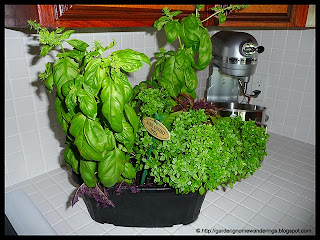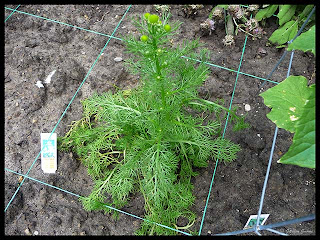[Please note that this is not a paid post. I am not being compensated by JM Chemicals but rather sharing a neat product I found with you.]
We went to a couple of fleamarkets while on vacation. It's a great way to spend the morning and you never know what you will find. Quite often there is one or more booths selling plants and there are always a few booths selling fresh local produce. Well there you go fresh produce and plants in one location so how could you go wrong?
One booth we stopped at was selling
Deco Beads aka
waterballs in various colours. The display was quite pretty so I ended up buying a large package of the very small crystal beads. Waterballs are made by JM Chemicals. SoilMoist™is a non-toxic, environmentally friendly polymer that stores water then releases it to the plant as needed essentially acting as a water reservoir. The waterballs are the decorative form of SoilMoist™ meant for a variety of decorating purposes from water plantings to centerpieces with flowers and/or candles. Unlike SoilMoist™ that must be incorporated into the soil at the root level of the plant, the waterballs are meant to serve a decorative function.
JM Chemicals has a wide variety of products to help with the home gardening watering needs.
The SoilMoist™ polymers reduce your plant waterings by 50%, reduce transplant shock is effective in the soil for 3-5 years. They are an effective water management aid that is ideal for interior and exterior plantings. I can immediately see the usefulness for container gardening. While the company says these polyacrylamide crystals can be used for vegetables but there are
some concerns that when the polymer starts to breakdown they release acrylamide a known neurotoxin and possible carcinogen. For that reason I will not be using any form of these crystals in my edible garden beds or planters although commercial growers and other home gardeners are using them for edible plants. I think they will be quite useful for the decorative funtion indoors as well helping with water management for my outdoor flower planters and houseplants especially when we are away from home.

I have to say these beads are really interesting to watch. Mine did not come with instructions so I poured the contents of the small bag into a large stainless steel mixing bowl. I poured a couple of cups of water over the beads then waited patiently (or not so patiently). About an hour later this is what the waterballs looked like. There was still a fair amount of water in the bowl so I just left it thinking that perhaps the waterballs weren't going to work. However after another hour the water was all absorbed so I poured more water over the plumping little waterballs. By late evening the water was once again absorbed so I covered with more water and left them until the following morning.

In the morning all the water was absorbed with the middle section of the waterballs in the bowl indented so I poured in more water to cover. By lunch time the waterballs were ready to use. I was quite impressed by how much the waterballs had increased in size! Each was now about the size of a marble that glittered and sparked everytime the light caught them.
The real trick seemed to be over saturating them with water then giving them the time to absorbe the water. I used a large slotted ladle to scoop the waterballs into 4 clear glass vases for planting.
As I filled the vases I wondered what to plant in them. I figured they would be perfect for rooting cuttings and a bit prettier than a plain jar of water plus the waterballs would keep the cuttings upright with no further supports. I made a couple of cuttings from my pothos plant that really does need a bit of trimming and a couple cuttings of
English ivy,
periwinkle and another smaller unidentified vine from the outdoor gardens. These are outdoor plants I like but in controlled areas. Once the plants are rooted I will pot them in soil with SoilMoist™ crystals added. I set the planted vases in a couple of windows. I really do like how the waterballs glisten and glitter!
I have these containers out of the reach of little hands. The waterballs would be something any child would love playing with. They are definitely on the textural side of things similar to wet gummy bears but not as sticky. Even I loved the feel of running my hands through them! I will be experimenting more with this type of soil-less potting medium. For any plant left in the waterballs at some point a fertilizer will be needed but that would be the same as any plant left in a jar of water. I can see lots of geranium cuttings lining my window sills this winter! I have already ordered the non-decorative crystals for my flower pots and houseplants so hopefully they will be and effective part of my water management strategy during extended periods when we aren't home.
Happy Gardening!
Garden Gnome
©2006-2010























































